The boat heaves and tosses in the grey water. Staying inside, I run the very probable risk of getting intensely seasick, so the only place for me is on the stern deck, against the railings focusing on a horizon where the slightly greyer sky meets with the darker grey of the water. The fact that the boat’s spray constantly whips past me, dampening my jacket and crusting my face with salt only makes the ride more exciting. Nevertheless, I am more than a bit relieved when the boat throttles down and begins to angle for the concrete jetty on the island of Inis Meain.
I have come to this smallest of the Aran Islands off the coast of Ireland to research John Millington Synge for a book I am writing on the Irish Literary Revival. Synge was one of those Irish authors around the beginning of the twentieth century that put Ireland on the world’s cultural map. He helped create, along with the poet William Butler Yeats and Lady Gregory, an Irish National Theater that became the world famous Abbey Theatre in Dublin.
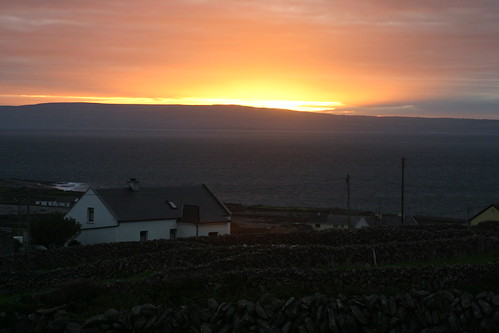
Aran sunrise
From 1898 to 1903, Synge spent parts of his summers on the Aran Islands, three tiny chunks of rock strewn across the mouth of Galway Bay on the west coast of Ireland. These small islands had been home to men and women who literally carved their existences out of the rock or pulled it from the raging sea. The Arans are the last things before the open Atlantic and have therefore been left alone for much of their history. Synge came to these islands to get a sense of a primitive culture that was thought to be more pure than in any of the other Gaeltacht (or Gaelic speaking areas) left in Ireland.
Synge was not the first (and certainly not the last) to get this idea. In fact, it was Yeats, visiting Synge in Paris after coming to the island in 1896 with Arthur Symons, who told Synge to go to the Aran Islands. Scoffing at Synge’s attempts at writing poetry and literary criticism, Yeats told him “give up Paris. You will never create anything by reading Racine, and Arthur Symons will always be a better critic of French literature. Go to the Aran Islands. Live there as if you were one of the people themselves; express a life that has never found expression.” Synge took Yeats up on the suggestion and expressed that life in his landmark book, The Aran Islands.
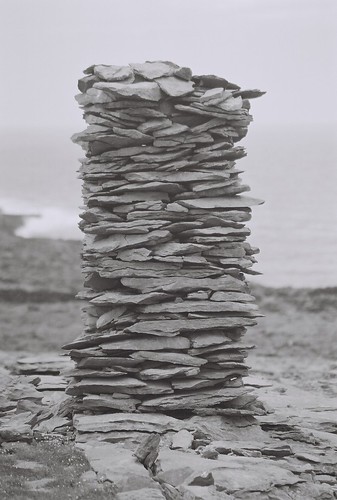
A carefully stacked rock cairn on Inis Meain
Over the next twenty-four hours, my job will be to look at the places Synge looked, walk where he walked, and try to get a sense of how this place affected what he wrote. However, my first job will be to find a place to stay. The woman at the ferry counter who sold me my ticket to the island assured me there were lots of bed and breakfasts on the island, and, given that it is the off-season (October), there’s no danger of all the rooms being sold out.
As the boat pulls gently up to the pier in still rolling waves, I look out at the cluster of houses clinging to the sides of the rocks and realize there is another danger. All those bed and breakfasts she told me about may be closed for the season. I see maybe four lights on in houses across the entire island. About the moment I panic and turn back to the boat to see if I should ride it back to the mainland for the night, the huge engines roar back to life and the boat pulls off away from the pier. There seem to be only four people on the entire island, and one of them is me. Another is a woman who shoulders her bag and quickly heads off into the gathering dusk.
That leaves me with another couple who are slinging what appear to be weekend backpacks over their shoulders and heading also off into the dark. I decide to follow them. Night doesn’t drop on the Aran Islands; it slams down with finality and is accompanied by the eerie sounds of the wind whistling through the stone walls. I quicken my pace to catch up to the couple ahead of me.
Relieved, I see them knock at the door of the Tig Congaile Bed and Breakfast. I hurriedly follow them as the lights come on and the door opens. By the time I arrive, the woman who rode the boat in with us and disappeared so quickly into the dark is nearly through checking them in and turns to me with surprise.
“Yes?”
“Do you have any rooms available for tonight?”
“Do you have a reservation?”
“No, do I need one?”
At this point, the gods smile on me. She replies, “no problem, I will just need to make a room up for you. I had only prepared their room before I left and I just got off the boat with you.” After making up a delightful room for me (light wood furniture, spotlessly clean), she has another question for me.
“What would you like for dinner?”
“What do you have?”
“Well, I have some stew frozen that I can thaw out, or steak and eggs, or, if you’d like, I brought some fresh salmon home and can make that with some potatoes.”
By the time I finish the salmon, I am congratulating myself on my absolute luck. The room was fantastic, the salmon absolutely delicious, and the entire thing was only costing me 35 Euros (about 45 dollars).
Synge had similar luck when he arrived on Inis Meain. He stayed with Brid and Padraig MacDonnchadha, who not only welcomed Synge into their tiny cottage, but gave him the best room. In addition, their son, Martin MacDonnchadha, served as Synge’s guide to the island, walking him around and introducing him to locals.
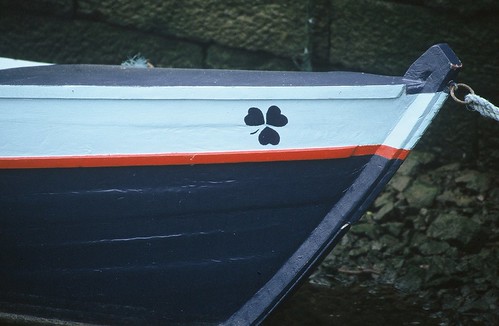
In the morning, I set out to visit their cottage, which has recently been renovated and reopened as a Synge museum. When I get there, however, everything is locked up tight. There is no sign on the door with posted hours, just a sign on the corner saying Teach Synge (Synge Cottage). For the moment, I will have to move on to another of Synge’s favorite haunts on the island.
A ten minute walk up through a lace network of stone walls leads to the Dun Chonchuir, the remains of a massive stone fort that once guarded the town. In 700 B.C., the circular fort (as was very common in this part of Ireland) served as an easily defensible position against hostile neighboring tribes on the other islands and, later, marauding Vikings. It is now a quiet circle of grass surrounded by crumbling stone walls some twenty feet thick in places. Synge would come up here to have a smoke, maybe a nap, and occasionally a chat with one of the locals who would come up to see if there was anything interesting in Synge’s newspaper.
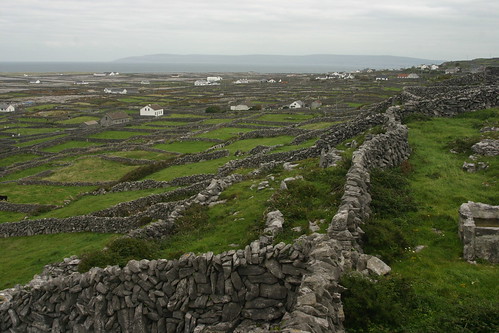
Once I’ve had my smoke (it was a bit too cold to nap), I amble back down to Teach Synge to see if it had opened up yet. Still no sign of anybody around, so I head off to what is known as “Synge’s Chair” (Cathoir Synge in Gaelic). According to what I’ve read, Synge found one of the most remote places on this remote island, and created a little shelter for himself by piling rocks up in a small semi-circle enclosure. The owner of Tig Congaile told me to follow the one main road on the island until it reached the end and then follow the signs to the path. I would know when I reached his chair because it would be the pile of rocks with a small plaque proclaiming Cathoir Synge.
I trudge off on the only main road on the island and one of the few roads I can see anywhere. Along my left is a steep rise completely covered with the loose shale seen everywhere on the island. On my right are hundreds of postage-size fields, walled off completely with rocks. There are rocks literally everywhere. Rock walls five feet high and two feet wide run crazily across the landscape. Sheep and cattle are hedged in to fields not much bigger than a basketball court. The fields and rock walls lead straight down to the water, or in some cases, right off the cliffs that rise up out of the water. Sheep cling to the sides of the island, silhouetted against an ocean that is two-hundred feet below them.
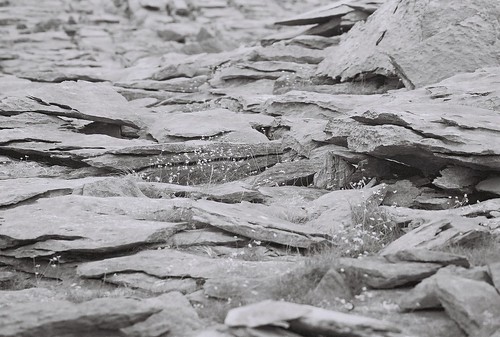
One of the main industries on the island is certainly raising sheep. Of course the lambs are used for meat, but the islanders traditionally don’t eat much meat. They can make more money selling the lambs on the mainland. The wool is brought down to the Inis Meain Knitwear factory, which is an odd anachronism on this island that time forgot. The showroom for the Inis Meain Knitwear factory is done with large glass windows, funky lighting, modern furniture and intelligent displays. It could just as easily be the newest store in New York. In fact, Inis Meain Knitwear sweaters, scarves, gloves and shirts can be found in Bergdorf’s and Saks.
The other way to make money on Inis Meain is by fishing and lobstering. Many men still use the traditional curraghs that have been used on the island for centuries. Instead of heavy fiberglass or steel boats, the Aran islanders use stretched canvas over a light wood frame. The canvas is tarred to make it waterproof, and the men wear special pampooties rather than shoes or boots so as not to tear the canvas. They lobster in much the same way they did in Synge’s time – by setting traps, waiting for the lobsters to enter them and then hauling the heavy traps into a boat that is chucking and rolling in the surf. Nowadays, however, the lobster catch is airlifted straight to Paris.
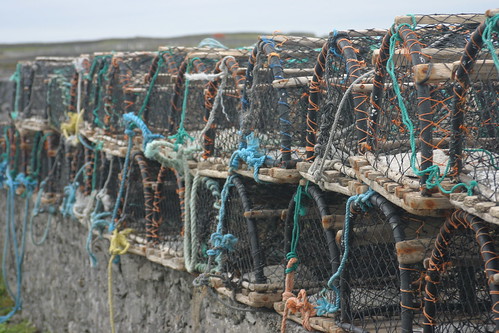
At then end of the road, I do find a sign pointing me up and over one of the nearest stone walls and across a field made entirely of loose stone. After that, I climb over another stone wall and look around in amazement. It is as if the islanders just couldn’t stop making stone walls. There are stone walls dividing up fields of stone. There is no grass on these fields, just slate. I also pass huge piles of stone, but not just piles. This stone has been stacked in wonderful square towers five and six feet high. It is difficult to tell whether these were done by locals or visitors with too much time on their hands, but they are certainly an impressive sight against the bleak expanses of rock.
After another couple of stone fields separated by rock walls, I come to a rough semicircle of stones piled up and a plaque confirming that this is, in fact, Synge’s chair. I go around to the front where there is a natural seating area and plant myself. Facing out, I see what he saw: the raging sea and the southern tip of the northernmost island, Inis Moir. I can see two dozen houses scattered around its only town, Cill Ronain. As I inch forward toward the cliff, I can also see the water some three hundred feet below me and can hear where those rolling waves coming in off the Atlantic hit the first land they’ve seen in thousands of miles. However, I can’t see where the surf actually hits; it’s too far down.
Synge often brought his notebook here and wrote while he sat and smoked, so after I have my lunch, I bring out my notebook and pipe. The problem is that the view is entirely too distracting. I want to watch the enormous waves roll through the channel for hours. I can see County Mayo off in the distance, just as Synge often could when the weather was clear. I put my pen and notebook back in my backpack and concentrate on enjoying the sheer isolation of his study.
It is late afternoon by the time I head back into town to give Teach Synge one more try. Alas, it is still closed up tight. However the tiny general store across the street has opened, so I head in to buy some postcards and water. Before I can open my mouth, the kindly, ruddy-faced man behind the counter asks if I am enjoying my stay on the island. I am clearly not from around here. I explain why I’m here, and we chat for a while. He shows me a poster from when the Druid Theatre of Galway came to the island in the summer of 2005 to perform the entire Synge cycle in Dun Chonchuir. Apparently the performances under the stars were truly magical; they also brought in hordes of guests to the island from as far away as Tokyo and New York. The shows were even reviewed in the New York Times.
I ask him about Teach Synge. “Oh,” he says, “You’ll have to hunt down Martin. He’s around here somewhere. He’ll open it for you.” He heads out onto the porch and squints into the sun. “Ah sure, there he is on his tractor heading this way,” and he points out a man on a tractor driving up the long slope behind the cottage.
By the time I pay for my things and get back across to the cottage, Martin has already hopped off and is in his yard taking down the wash that was hanging out to dry.
“Hello,” I call out. “Is it possible to open up the cottage? I’m a writer from America doing a book on Synge and…” Without a word, Martin turns and walks into the house. Stunned, I have absolutely no idea what to do. I stand in the road confused until he pokes his head around the cottage and calls out “will you be coming in or no?”
Stooping through the low doorway, I enter the room where Synge sat for weeks on end gathering stories from the local wise men and chatting with the young girls. Martin shows me Synge’s room, cleanly whitewashed and sparse with just a bed and a chair. In another room, there was a whole display set out on the bed describing the renovation and the reopening ceremony. The playwright Brian Friel, the actor Stephen Rea, and the Irish scholar Declan Kiberd, along with many others gathered on the island to celebrate Synge’s legacy and the reopening of the house. The main room, where all the cooking and conversation took place, has been set up to recreate Synge’s time there with woolen socks drying by the fire and a teakettle on the hob. Perhaps that is why everything has a made up feel to it, and, after giving some money to help with thatching the roof (a time consuming and expensive exercise), I shuffle back down the road to the Tig Congaile to pick up my bag before I get back on the boat to go back to the mainland. I think back over the day and where I felt the most connected to the genius of Synge. For me, sitting looking out over the ocean, watching the same water come rolling in off the Atlantic as it had for millions of years, I could understand what kept him coming back to this island and why he wrote so passionately about his time here.
The winds have shifted by the time I step back on the boat and the trip back to shore is a relatively smooth one. It is dusk and I don’t have a place to stay again. But I’m following Synge’s paths tonight into County Mayo, the setting for his play, The Playboy of the Western World, that set Dublin to rioting in 1907. I have faith I’ll find something.
Robert Todd Felton is the Literary Travels Editor for Wandering Educators.
He's written several books, including A Journey into Ireland's Literary Revival, and A Journey into the Transcendentalist's New England. You can explore more of his work, and his books, at http://www.rtoddfelton.com,
his author page, www.redroom.com/author/robert-todd-felton,
or his blog, http://openpage-openroad.blogspot.com/
